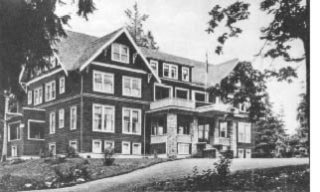Sweeping up to the front portico of the Belvedere Hotel in one’s roadster was a pretty exciting experience during the 1920s. Standing on the headland high above the Sooke River bridge, the view from the four-storey hotel took in the Sooke Harbour, Government Wharf, and Whiffin Spit.
Built in 1912 by Seattle interests, the hotel, which had its own lighting plant, was expected to house potential purchasers who would come to look at land development. The building of the hotel was connected to the railway that carried logs from far up in the DeMamiel Valley, hauling the logs by steam locomotive and flatdeck to a wharf at the Belvista area near the museum, where they were dumped into the saltchuck.
Some thought the hotel was ahead of its time, but its history highlighted a period of Sooke’s development that has probably never been equaled. During prohibition, rumrunners are said to have known the hotel well.
In the 1970s, when interviewing Major George Nicholson, a well-known West Coast historian and author who had managed the hotel for a period, I could not get a direct answer to questions about rum running. Declining to speak on tape, the charming Major smiled roguishly and offered only broad hints about liquor caches.
In 1919, the dashing Prince of Wales (later the Duke of Windsor) was a guest. Prior to his Wallis Simpson days, while on the Island he visited a Royal connection, Lady Emily (Seymour) Walker at Ragley in East Sooke. In 1927 the Prince once again visited with Lady Emily.
Film stars stayed at the hotel and enjoyed excursions on fish packers such as the Harriet E, on their way out to the twice-weekly lifts of the fishtraps. Emily Carr stayed at the hotel from time to time, and would perch on her campstool painting scenes on tree fungus, which she sold for 35 cents. The French Consul, stationed in Vancouver, visited his family connections, the Robillards, in 1927, and engaged in big game hunting (for cougar).
Excursions with packhorses would set out from the stables at the foot of the hill, sometimes bound for hunting, sometimes bound for the Harrison Trail and the cabin of the Alpine Club of Canada at Sheilds Lake. When the hotel burned in 1934, the stables were left, and eventually were developed into the Sooke River Hotel and Castle. Three of the historic pillars in the photo were salvaged later by the Sooke Region Historical Society and re-built at Macgregor Park.
Elida Peers
Historian, Sooke Region Museum
